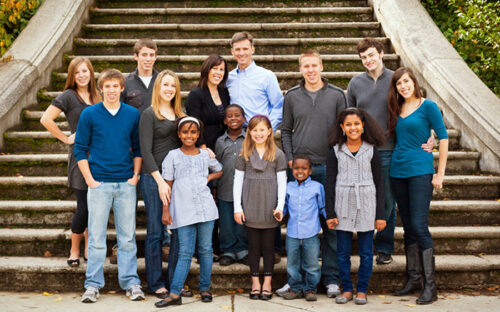Parenting: Draw your own circles
Many and varied types of families
Drawing Family Circles
Families – It’s OK to be “different”
by Gregory A. Barrett, M.D.
Families are so fascinating! For me, personally discovering and gaining an appreciation of all the various types has been one of the most intriguing aspects of my life as a pediatrician. There is, of course, the classic structure of Dad working and Mom staying home with the kids, but then there is also the single mom, career couples, foster families, divorced parents with shared custody, the stay-at-home dad, adoption both domestic and foreign, gay couples, children being raised by a grandparent, and on and on and on and on, in a never-ending variety.
One absolute fact I have personally witnessed is that each and every one of these formats can function wonderfully effectively, as long as there is an underpinning of respect, common sense, commitment, and love. It is okay to be different. Furthermore, it is perfectly acceptable within all of these assorted units to have differing values, expectations, and priorities for their children. And this is where my concept of Drawing Circles comes into play.
Diverse Families

Individual families will vary greatly on what they consider important. I sincerely believe that every set of parents is entitled – and obligated – to draw a circle on a piece of paper and declare that the area inside matters and everything outside will simply not be a major concern. Now some will draw bigger circles than others, and oftentimes their circle will overlap only a little bit with someone else’s or not match up at all, but that’s fine. There is no such thing as a morally superior circle; no one circle is inherently better than another. However, parents do need to take care in drawing the lines. It is imperative for them to sit down and give some thought regarding what they prioritize as being important in their home. Moms and dads should not be flying by the seat of their pants, making decisions on the run, or being wishy-washy and wavering from one day to the next. That leads to chaos. In the grand scheme of family life it is not really all that important where you stand on any particular issue – what is important is that you stand for something.
DON’T BE AN ACCIDENTAL PARENT
Let me re-emphasize that it is not enough to simply take out a pencil and draw a random circle. Instead give some careful thought about what you’re doing and why in advance, make conscious decisions, create a plan, and then be consistent. Your children need this. The truth is they crave structure, whether they ever acknowledge it or not (usually not…). It is the responsibility of the parent(s) to always remember precisely where their circle is drawn on the paper, and that the lines be stable.
Admittedly this concept of Drawing Circles is rather abstract and confusing, so let me attempt to clarify with a few concrete examples.
Messy Room

Clutter and mess just don’t seem to bother some families. And that’s perfectly okay. You walk in the front door of one of these homes and your initial impression is that the living room has recently been struck by a tornado, but it is absolutely fine if the parents have made a conscious decision that tidiness is not included in their circle. For another family neatness is considered a virtue. Little kids are responsible for their toys. Dishes are to be carried to the sink, rinsed, and placed in the dishwasher. Family pets are expected to use the litter box. Even the inner sanctum of their teenager’s bedroom must meet a certain minimum standard! The mother and father set the standard and then the children are required to follow their example. So disorder versus order, what’s it going to be? It’s up to the parents to decide, but decide they must. Inside the circle – or not.
Eating Breakfast
There are those families who just don’t seem to sweat mealtimes. They allow grazing between breakfast, lunch, and dinner, and all kinds of animalistic behavior from their child during a meal without concern. And from a pediatric perspective, or course, all that truly matters nutritionally is the amount and quality of the food ingested over the course of a week, so that is acceptable. For others a certain code of conduct is expected at the table. In a home such as this when the toddler starts tossing his applesauce onto the floor he or she is out of the highchair and the meal is finished! Down you go, kid, nothing but water until breakfast is served the following morning. You’ve had your chance. Two contrasting ways to handle this issue, no right or wrong. However, the parents need to choose.
Watch Your Language

One family may be extremely sensitive about their child’s language. Potty-mouth and disrespect will absolutely not be tolerated at any age and a stern, appropriate consequence will immediately ensue. And that’s totally acceptable. On the other hand, another may have a “sticks and stones may break my bones, but words will never hurt me” philosophy and, after initially pronouncing disapproval of the four-letter bombshells, they will simply ignore them. These folks are practicing extinction by inattention following the approach of ignoring negative behavior and not rewarding it with even the slightest response. Now I dare say none of us thinks it’s particularly cute when our preschooler comes home with some spicy new words or expletives begin rolling smoothly off the tongue of our newly minted adolescent. We can all agree that this is utterly obnoxious. The divergence comes with deciding how to handle it. Define it as allowable or not allowable and proceed from there.
Sleeping Baby
Some moms and dads let their children sleep with them. Hey, there is nothing wrong with that, as long as they don’t mind. The American Academy of Pediatrics does officially frown upon this custom due to concerns regarding safety but [my writings] were never intended to be a mouthpiece for the A.A.P. in the first place and, come on, it’s a fact, people are doing it all over the world regardless. Of course, this should never occur unintentionally (“Honey, do you realize Jenny’s been sleeping in our bed for the last nine months? Geez-O-Peet. How in the heck did that ever happen?”) or because of some bizarre misconception that their child is the first one born in the history of mankind who is unable to sleep on a crib in their own room, but if the mother and/or father feel that it’s a comfortable arrangement and it works for them then alright, so be it. Obviously, this cannot be a permanent situation, and there will be some consequences and tough times later when the day comes to change the house rules, but it is certainly okay as long as it is a conscious choice. However, if it is not then somebody needs to go back and re-examine their priorities. For others the parental bedroom is a sacred, private place strictly off limits to their children (excepting, of course, for the occasional thunderstorm) and this is enforced from an early age. In other words, they place sleep habits inside their circle. It matters to them.
Family

Assuming these examples were helpful in gaining an insight into this critical fundamental of effective parenting the time has now come for all of you to go ahead, grab yourself a piece of paper and a Sharpie (not a pencil…too erasable), and draw your circles. Decide on your particular priorities, what is important to you and your family and what is not. And please, I beg of you, don’t be judgmental of others. There’s already far too much intolerance going on in the world today, don’t you think? We certainly don’t need any more. Remember, there is no such thing as an ideal circle. My circle may be different than yours – in actuality it probably will be, given the fact that no two circles are ever drawn exactly the same – but that doesn’t mean there’s anything wrong with it. It just means it’s my circle.
Families…they are so fascinating, aren’t they?
☤


